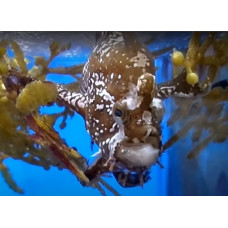Latin name
Histrio histrio
Other names
Anglerfish, frog fish
Identification
The name comes from the Latin word "histrio", meaning "actor", and is related to the behaviour of the fish. The body is short and slightly flattened at the sides. The pattern on the body and mouth is very variable, but usually consists of dark yellow, dark brown or dark green spots on a pale background. The fins are also covered with dark stripes and spots. Fish can change colour quickly from dark to light and vice versa. The fins are large (especially the pelvic fins). The pectoral fins have 9 to 11 rays and elongated leg-like blades. The dorsal fin has three separate barbs followed by 11 to 13 soft rays. The anal fin has no spines and consists of 7-13 rays. The first barbed ray is directed forward and turns into a "fishing rod" called the illicium. At the end of the illicium is the worm-like esca, which is used to attract potential prey. The length of the illicium is half that of the second barb.
Distribution
The species is cosmopolitan and occurs in all seas of the tropical and subtropical belts, including the Sargasso Sea and the vicinity of the Galapagos and Hawaiian Islands. It is found in the waters of the southern Primorsky Krai. It has been reported to have been caught off Norway, but the fish was probably transported by the North Atlantic current.
Habitat
The only species in the frogfish family whose members live in the water column in sargassum thickets of sargassum algae (all others are benthic fish living at depths of up to 300 metres).
Size
The maximum body length is 20 centimetres.
Life history and Behavior
During spawning, the male performs a mating ritual to attract a mate. Before spawning, the female rises to the surface and then releases many eggs covered in a gelatinous slime.
Food and feeding habits
An active ambush predator that practises cannibalism. The fish hunts camouflaged between thickets of sargassum. It can grasp and move between the algae stalks using the strong rays of its pectoral fins. Esca is used to attract small fish, crustaceans and other invertebrates. It is able to draw prey into its mouth by pushing water out of the mouth cavity through the gills, creating a low-pressure zone into which prey rushes. The mouth can expand rapidly to many times its original size to swallow large animals.
Reproduction
Laying eggs. The eggs attach to algae where they are fertilised by the male. After hatching, the larva is covered with a cover membrane, has a rounded head, fully developed fins and eyes. As the larva grows older, the covering membrane fuses with the skin.
| Classification | |
| Phylum | Chordata |
| Class | Actinopterygii |
| Squad | Lophiiformes |
| Family | Antennariidae |
| Genus | Histrio |
| Species | H. histrio |
| Features | |
| Conservation status | Least Concern |
| Habitat | Pelagic |
| Life span, years | No information |
| Maximum body weight, kg | No information |
| Maximum length, cm | 20 |
| Sailing speed, m/s | No information |
| Threat to people | No information |
| Way of eating | Predator |
Sargassum fish
Tags: sargassum fish



